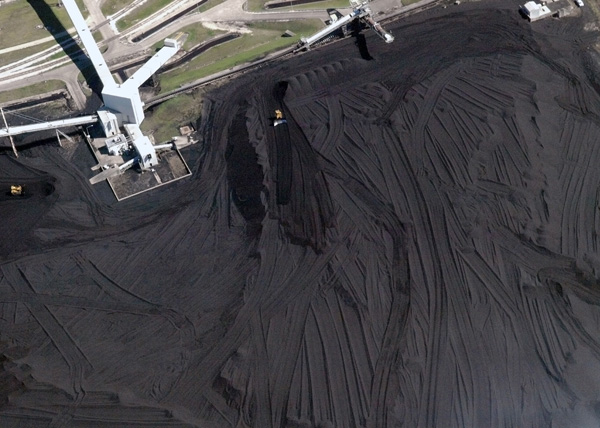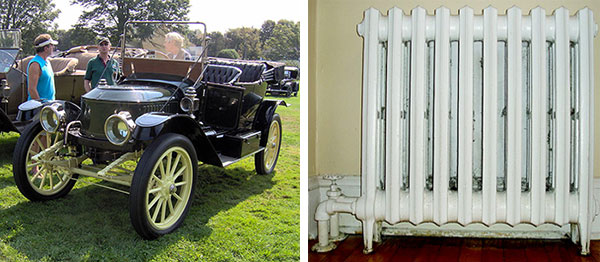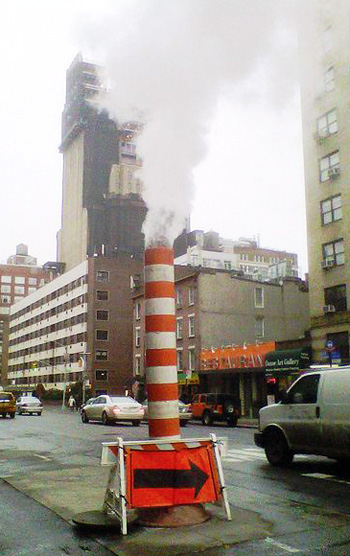So the 20th century departed radically from all we'd understood about energy — what it was and how it was to be harnessed. But as our understanding shifted, coal gave way, in part, to the new energy source of petroleum. Oil was suddenly so plentiful as a coal supplement that it erased our concerns for a season. Only late in the century did we again feel the pinch of limited supplies.
And we finally looked elsewhere to feed our voracious appetite for the eternal delight of energy. Today, we've added natural gas, nuclear power, geothermal energy, and various renewable forms of energy to coal. But the catch is that, while the fuel has changed, steam remains. (Of course coal remains, as well.)

Aerial view of the huge coal pile supplying a Houston-area power plant. Note the diesel shovel looking tiny in the upper center. [Photo by J. H. Lienhard]
Beyond driving our gasoline and diesel vehicles, those fuels also provide about 40 percent of the power we consume using steam turbines in the big power plants. Even many of our renewable forms of energy power steam turbines. Steam is the agent of far more power delivery today than it was in the 19th-century Steampunk era.
Sure, today we hear William Blake's line, Evil is the active springing from Energy. But steam remains because it's the agent of the most efficient means for putting energy to use, regardless its source. William Jevons warned us that efficiency won't save us from energy-greed. Still, we'd be crazy if we didn't access greater efficiency when it's to be had.
Steam was still the obvious agent of power production as we left the 19th century. For a while it seemed that even automobiles would be driven by steam. Before the Wright Brothers, airplane and dirigible builders thought steam would drive their engines.

Left image: 1912 Stanley Steamer automobile. Right image: a vintage steam radiator [Both images courtesy of Wikimedia Commons]
In fact most of us had steam heat in our homes until after WW-II. The 1954 musical, Pajama Game, gave us a wonderful song, Steam Heat. When the younger among us hear it, it won't call up associations. But those of us of a certain age will remember the hiss and clack of the steam radiators that kept our rooms warm in winter.
For us, the song brings back the texture of childhood. Listen as Danielle Reich sings it for us:
I've got steam heat.
I've got steam heat.
I've got steam heat.
But I need your love to keep away the cold.
I've got steam heat.
I've got steam heat.
I've got steam heat...
The radiators hissin still I need your kissing to keep me from freezing each night ...
I've got a hot water bottle, but nothing I've got'll take the place of you holding me tight.

An iconic vent in the New York City steam heating system. [Image courtesy of the Wikimedia Commons]
Steam heat is less efficient than, say, natural gas — so commonplace today. But there's a catch. The laws of thermodynamics require those big municipal power plants, with their steam turbines, to reject an amount of heat. The laws of thermodynamics say explicitly that some energy must remain unused in a power plant.
But that low-grade energy can be further milked to create steam at, say, 12 times atmospheric pressure and 360 degrees Fahrenheit. Those are pretty low temperatures and pressures in comparison with the superheated steam in the power plant. Parts of New York City are served with large underground pipes carrying that steam to heat, and even air-conditioned buildings.
So much of the delight seems to've gone out of steam. New York still has its iconic steam vents, but we no longer see the steam discharges as we board a train. Well, we seldom board a train anyway. When we do see steam vented from industrial plants, we often mistake it for smoke. So much for romance. We are, I suppose a more serious people these days, so let us finish with a look at one of America's immense commercial centers.
Sources
The original motivation for the title of this track was Patti Page’s classical singing of the song Steam Heat. For the audio in this track we went to noted Austin, TX, song stylist, Daniel Reich, who recreated the song for us.